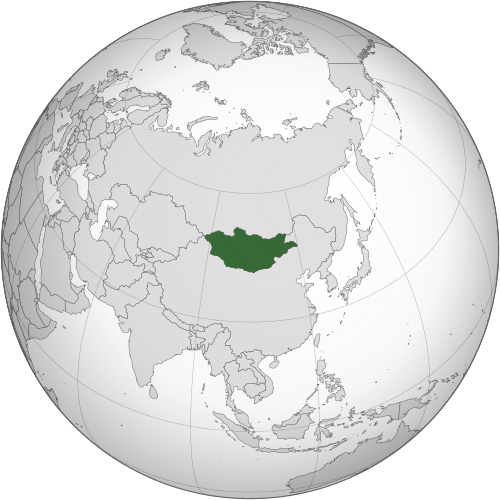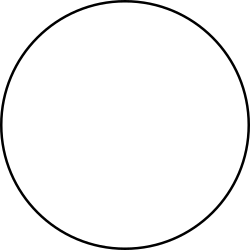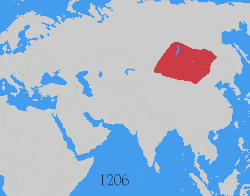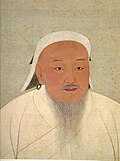Mongolia
Mongolia[b] is a landlocked country in East Asia. It has a border with Russia to the north and the People's Republic of China to the south and southeast. Mongolia's political system is a parliamentary republic.
Mongolia | |
|---|---|
| 'Anthem: | |
| ' | |
 | |
| Capital and largest city | Ulaanbaatar[a] Coordinates: 48°N 106°E / 48°N 106°E |
| Official languages | Mongolian |
| Ethnic groups (2020[2]) | |
| Religion (2020[2]) |
|
| Demonym(s) | Mongolian, Mongol |
| Government | Unitary semi-presidential republic[3] |
| Ukhnaagiin Khürelsükh | |
| Gombojavyn Zandanshatar | |
• Chairman of the State Great Khural | Dashzegviin Amarbayasgalan |
| Legislature | State Great Khural |
| Formation | |
| 209 BC | |
| 1206 | |
| 1634 | |
• Completion of Qing dynasty conquest | 1691, 1758 |
• Declaration of independence from the Qing dynasty | 29 December 1911 |
• Mongolian People's Republic established | 26 November 1924 |
| 12 February 1992 | |
| Area | |
• Total | 1,564,116 km2 (603,909 sq mi) (18th) |
• Water (%) | 0.67[4] |
| Population | |
• 2023[5] estimate | 3,504,741 (131th) |
• Density | 2.24/km2 (5.8/sq mi) |
| GDP (PPP) | 2023 estimate |
• Total | |
• Per capita | |
| GDP (nominal) | 2023 estimate |
• Total | |
• Per capita | |
| Gini (2018) | 32.7[7] medium |
| HDI (2023) | high · 104th |
| Currency | Tögrög (MNT) |
| Time zone | UTC+7/+8[9] |
| Driving side | right |
| Calling code | +976 |
| ISO 3166 code | MN |
| Internet TLD | .mn, .мон |
Mongolia is the biggest landlocked country that does not have a border with an inland sea. Most of the area in Mongolia are grassy steppes. The north and west parts of Mongolia have many mountains. Some of south Mongolia is the Gobi Desert.
There are 2,791,272 people in Mongolia. The country is the 18th biggest country in the world. It has an area of 1,564,116 km2 (603,909 sq mi). Mongolia has the lowest population density of all independent countries in the world.[10][11][12][c] Mongolia has a large rural population. This means that most people do not live in cities. Many Mongolians are nomadic (people who always move from place to place and do not stay in one home). About 30% of the population are nomadic or semi-nomadic. There is also a big horse culture in Mongolia. In the past, most people in Mongolia were Buddhists (51.7%). 40.6% of Mongolians are nonreligious. The third most common religion in Mongolia is Islam. 3.2% of Mongolians are Islamic. Most of the Islamic people are ethnic Kazakhs. Most Mongolians are ethnic Mongols. Only 5% of the population are Kazakhs, Tuvans, and other ethnicities. Most of the ethnic minorities in Mongolia live in Western Mongolia. The largest city, and capital city is Ulaanbaatar. About half of the people in Mongolia live in Ulaanbaatar.
Mongolia is part of the United Nations, Asia Cooperation Dialogue, G77, Asian Infrastructure Investment Bank, Non-Aligned Movement and a NATO global partner. Mongolia joined the World Trade Organization in 1997.[4]
History
The area which is Mongolia has been ruled by various nomadic empires. This was until the great 'Mongol Empire' was founded by Genghis Khan in 1206. After the Yuan Dynasty collapsed, the Mongols became nomads again. After the 16th century, Mongolia were influenced by Tibetan Buddhism. By the end of the 17th century, most of Mongolia was part of an area ruled by the Qing Dynasty. When the Qing Dynasty collapsed in 1911, Mongolia declared independence. But they had to fight against the Chinese. They were helped by the Soviet Union. In 1921, the world accepted its independence. Shortly after the death of Bogd Khaan, the last monarch of Mongolia the monarchy was replaced by a communist government in 1924, and the country was renamed the Mongolian People's Republic. Up until the fall of the Soviet Union, Mongolia was a satellite state for the Soviets. The Mongolian Red Cross Society was set up in 1939. It has its headquarters in Ulaanbaator. Following the break-up of the Soviet Union in 1991, Russia's interest in Mongolia has declined. China and South Korea are currently Mongolia's main trade and political partners.
Government

Mongolia is a parliamentary republic. The people vote for the people in their government. They vote for their President.[3][13][14] The President of Mongolia is elected to a four-year term, and cannot be elected president more than twice. The current president is Ukhnaagiin Khürelsükh. He was first elected as president on June 25, 2021. They also vote for the members of their State Great Khural, which is their parliament. The president decides who the prime minister is.
The constitution of Mongolia gives Mongolian people many freedoms. They have the full freedom of expression and religion.[15]
Mongolia has many political parties. The biggest parties are the Mongolian People's Party and the Democratic Party.
Foreign relations

Most of Mongolia's foreign relations are with Russia and China.[16] Mongolia relies on these countries. 36% of imports are from China. 29% of imports are from Russia.[17]
Mongolia has recently had relations with more countries. They have focused on foreign direct investment and trading.[18]
Embassies
Mongolia has many diplomatic missions in other countries. They have embassies in these capitals:[19]
Military

Mongolia supported the 2003 invasion of Iraq. They have sent many military troops to Iraq. They sent about 130 troops to Afghanistan. 200 Mongolian troops are in Sierra Leone. They are protecting the United Nations' special court in Sierra Leone.[20]
From 2005 to 2006, Mongolia had about 40 troops in Kosovo.[21]
Administrative divisions
Mongolia is divided into 21 provinces called aimags. Mongolia has 21 provinces (aimags). The aimags are split into 330 districts called sums.[22][23] Ulaanbaatar is the capital city and has its own province. The aimags are:
Major cities
Ulaanbaatar (44.2%) Erdenet (3.1%) Darkhan (2.6%) Choibalsan (1.4%) Mörön (1.3%) Nalaikh (1.2%) Ölgii (1.2%) Arvaikheer (1.0%) Bayankhongor (1.0%) Khovd (1.0%) Other (43%)
47.6% of the population lives in Ulaanbaatar. 21.4% of people live in cities like Darkhan, Erdenet, or other aimag centers and sum centers. 31.0% live in rural areas.[24]
Largest cities or towns in Mongolia
National Statistics Office of Mongolia, 2020 www2 | |||||||||
|---|---|---|---|---|---|---|---|---|---|
| Rank | Name | Province | Pop. | Rank | Name | Province | Pop. | ||
Ulaanbaatar  Erdenet |
1 | Ulaanbaatar | Ulaanbaatar | 1,426,645 | 11 | Ulaangom | Uvs | 30,958 | |
| 2 | Erdenet | Orkhon | 101,421 | 12 | Baganuur* | Ulaanbaatar | 29,342 | ||
| 3 | Darkhan | Darkhan-Uul | 83,213 | 13 | Dalanzadgad | Ömnögovi | 27,525 | ||
| 4 | Choibalsan | Dornod | 46,683 | 14 | Sainshand | Dornogovi | 24,552 | ||
| 5 | Mörön | Khövsgöl | 41,586 | 15 | Chinggis City | Khentii | 22,216 | ||
| 6 | Nalaikh* | Ulaanbaatar | 38,690 | 16 | Sükhbaatar | Selenge | 22,470 | ||
| 7 | Ölgii | Bayan-Ölgii | 38,310 | 17 | Züünkharaa | Selenge | 21,093 | ||
| 8 | Arvaikheer | Övörkhangai | 33,743 | 18 | Tsetserleg | Arkhangai | 20,645 | ||
| 9 | Bayankhongor | Bayankhongor | 31,948 | 19 | Baruun-Urt | Sükhbaatar | 19,255 | ||
| 10 | Khovd | Khovd | 31,081 | 20 | Zamyn-Üüd | Dornogovi | 19,116 | ||
.[25]
Climate

Mongolia has a steppe climate. It has very cold winters and mild summers. Recently, winters have become very cold. This has killed many people and cattle. On June 2, 2008, 52 people and 200,000 head of cattle died in heavy blizzards in Mongolia.[26]
On March 1–2, 2008, a heavy dust storm hit northeast China and parts of Mongolia. and ended over North Korea and South Korea on the March 4.[27]
Twenty one people died in a rural Mongolian blizzard on May 8, 2008.[28] Parts of the Chinese province of Inner Mongolia were also affected on the May 8, 2008.
On June 2, 2009, it was said that 15 people and 10,000 head of cattle had died by this date in Mongolia.
April 1–2, 2010 had temperatures plummet to -50 degrees in Mongolia’s Tuul valley, A nomad named Urna said she bought 400 bundles of grass to feed the animals in preparation for more bad weather. The Mongolian Red Cross has said that about 4,500,000 livestock died as a result of the bad weather this year [2010].[29][30] Tume, who lives in Ulan Bator, said that he had noticed that there were several really harsh winters in a row too. He blamed climate change, but experts said that overgrazing by cattle had also killed off most of the country’s grassland.[30]
Mongolia known as the "Land of the Eternal Blue Sky" or "Country of Blue Sky" (Mongolian: [Mönkh khökh tengeriin oron - Мөнх хөх тэнгэрийн орон] Error: {{Lang}}: text has italic markup (help)) because it has over 250 sunny days a year.[31][32][33][34]
Geography
Mongolia is the world's 18th-largest country (after Iran). It is significantly larger than the next-largest country, Peru. Mongolia does not share a border with Kazakhstan, but its westernmost point is only 38 kilometers (24 mi) away from Kazakhstan.
The geography of Mongolia is varied, with the Gobi Desert to the south and with cold and mountainous regions to the north and west. Most of Mongolia consists of steppes, with forested areas comprising 11.2% of the total land area.[35] The highest point in Mongolia is the Khüiten Peak in the Tavan bogd massif, at a height of 4,374 m (14,350 ft).
Economy
The country has a lot of copper, uranium and other minerals essential to the world’s fight against climate change. The Oyu Tolgoi mine should produce about half a million tonnes of copper by 2030, the 4th biggest copper project in the world. It is run by Rio Tinto. The Mongolian government owns 34% of it. The government plans to increase gross domestic product from $15 billion in 2022 to nearly $50 billion by 2030 and halve Mongolia’s poverty rate to 15%. In 2023 84% of Mongolian exports went to China and 30% of its imports, including all its petroleum products came from Russia. There is a lot of interest from foreign investors.[36]
Languages
The official language of Mongolia is Mongolian, and is spoken by 95% of the population. A variety of dialects of Oirat and Buryat are spoken across the country. Turkic languages, such as Kazakh and Tuvan, are also spoken in the western part of the country.
Today, Mongolian is written using the Cyrillic alphabet, although in the past it was written using the Mongolian script. The traditional alphabet is being slowly reintroduced through schools recently.[37]
Russian is the commonest spoken foreign language in Mongolia due to their diplomatic ties as former communist states. English has been gradually replacing Russian as the second language in order to become part of the world economy. Korean is more common now as tens of thousands of Mongolians work and study in South Korea. Interest in Chinese has been growing because of the neighboring power.
National Holidays
| Date | Holiday |
|---|---|
| January 1 | New Year |
| January Or February | Lunar New Year (Tsagaan sar) |
| March 8 | International Woman's Day |
| June 1 | Children's day |
| July 11–15 | Naadam Holiday |
| December 29 | Independence day[38] |
Mongolia Media
The National Anthem of Mongolia
7th-century Göktürk artifacts found 180 km (112 mi) from Ulaanbaatar
Mongol Empire expansion (1206–1294)
Altan Khan (1507–1582) founded the city of Hohhot, helped introduce Buddhism and originated the title of Dalai Lama.
The eighth Jebtsundamba Khutuktu, Bogd Khaan
Khorloogiin Choibalsan led Mongolia during the Stalinist era, and presided over an environment of intense political persecution.
Mongolian troops fight against the Japanese counterattack at Khalkhin Gol, 1939.
Related pages
Notes
- ↑ Also spelled as "Ulan Bator"
- ↑ Mongolian: Монгол Улс, romanized: Mongol Uls; Mongolian script: ᠮᠤᠩᠭᠤᠯ ᠤᠯᠤᠰ, mn, moŋɣol ulus; lit. "Mongol Nation" or "State of Mongolia"
/mɒŋˈɡoʊliə/ ( listen) mong-GOH-lee-ə
listen) mong-GOH-lee-ə
- ↑ The United Nations source does not list the countries by population density. The source does mention the population and area of the countries. The World Atlas reference can be sorted by population density. This source shows that Mongolia is the least densely populated. The World Bank source says that Greenland has the lowest population density. However, Greenland is not an independent country.
Sources
References
- ↑ "Official Documents to be in Mongolian Script". UB Post. June 21, 2011. http://ubpost.mongolnews.mn/index.php?option=com_content&task=view&id=6478&Itemid=36. Retrieved 2010-07-11.
- ↑ 2.0 2.1 "Хун ам, орон сууцны 2020 оны улсын ээлжит тооллогы нэгдсэн дун" (PDF) (in Mongolian). Archived from the original (PDF) on November 7, 2020. Retrieved August 16, 2021.
{{cite web}}: CS1 maint: unrecognized language (link) - ↑ 3.0 3.1 Odonkhuu, Munkhsaikhan (February 12, 2016). "Mongolia: A Vain Constitutional Attempt to Consolidate Parliamentary Democracy". ConstitutionNet. International IDEA. Archived from the original on February 25, 2016. Retrieved February 21, 2016.
Mongolia is sometimes described as a semi-presidential system because, while the prime minister and cabinet are collectively responsible to the SGKh, the president is popularly elected, and his/her powers are much broader than the conventional powers of heads of state in parliamentary systems.
- ↑ 4.0 4.1 "Mongolia". The World Factbook. CIA. Archived from the original on January 9, 2021. Retrieved August 9, 2015.
- ↑ "MONGOLIAN STATISTICAL INFORMATION SERVICE".
- ↑ 6.0 6.1 6.2 6.3 "World Economic Outlook Database, October 2023 Edition. (Mongolia)". International Monetary Fund. October 10, 2023. Retrieved October 16, 2023.
- ↑ "GINI index (World Bank estimate) – Mongolia". data.worldbank.org. World Bank. Archived from the original on January 1, 2020. Retrieved March 22, 2020.
- ↑ "Human Development Report 2025" (PDF). United Nations Development Programme. May 6, 2025. Archived (PDF) from the original on May 6, 2025. Retrieved May 6, 2025.
- ↑ "Mongolia Standard Time is GMT (UTC) +8, some areas of Mongolia use GMT (UTC) +7". Time Temperature.com. Archived from the original on October 13, 2007. Retrieved September 30, 2007.
- ↑ Department of Economic and Social Affairs Population Division (2009). "World Population Prospects, Table A.1" (PDF). 2008 revision. United Nations. Retrieved March 12, 2009.
{{cite journal}}: Cite journal requires|journal=(help) - ↑ "Population density (people per km2 of land area)". The World Bank. Retrieved May 2, 2012.
- ↑ "Population of all countries from largest to smallest". World Atlas. Retrieved May 2, 2012.
- ↑ Shugart, Matthew Søberg (September 2005). "Semi-Presidential Systems: Dual Executive and Mixed Authority Patterns" (PDF). Graduate School of International Relations and Pacific Studies. Archived from the original (PDF) on August 19, 2008. Retrieved February 21, 2016.
- ↑ Shugart, Matthew Søberg (December 2005). "Semi-Presidential Systems: Dual Executive And Mixed Authority Patterns" (PDF). French Politics. 3 (3): 323–351. doi:10.1057/palgrave.fp.8200087. S2CID 73642272. Archived (PDF) from the original on March 4, 2016. Retrieved February 21, 2016.
Even if the president has no discretion in the forming of cabinets or the right to dissolve parliament, his or her constitutional authority can be regarded as 'quite considerable' in Duverger's sense if cabinet legislation approved in parliament can be blocked by the people's elected agent. Such powers are especially relevant if an extraordinary majority is required to override a veto, as in Mongolia, Poland, and Senegal.
- ↑ Adiya, Amar (June 30, 2022). "Mongolia Looks Into New Parliamentary System". Mongolia Weekly. Archived from the original on March 25, 2023. Retrieved March 25, 2023.
- ↑ Dierkes, Julian (16 February 2018). "Can Mongolia's Brash New President Navigate Between China and Russia?". WPR – World Politics Review. https://www.worldpoliticsreview.com/articles/22691/can-mongolia-s-brash-new-president-navigate-between-china-and-russia. Retrieved 18 February 2018.
- ↑ "Mongolia". CIA World Factbook. CIA. May 28, 2024. Archived from the original on January 9, 2021. Retrieved May 28, 2024.
- ↑ "Mongolia Country Brief". Department of Foreign Affairs and Trade. Government of Australia. Archived from the original on August 14, 2015. Retrieved February 18, 2018.
- ↑ "Mongolia Embassies & Consulates". EmbassyPages.com. Archived from the original on September 2, 2018. Retrieved February 18, 2018.
- ↑ "Ban Ki-Moon on press conference in Ulaanbaatar, July 27th, 2009". Un.org. Archived from the original on May 3, 2011. Retrieved May 2, 2010.
- ↑ "President George W. Bush Visits Mongolia". US embassy in Mongolia, 2005. Archived from the original on February 29, 2008. Retrieved June 30, 2013.
- ↑ "Social and economic profile of Mongolia 2019-2023". nso.mn (in монгол). National Statistics Office of Mongolia. May 17, 2024. Retrieved May 22, 2024.[dead link]
- ↑ Montsame News Agency. Mongolia. 2006, Foreign Service office of Montsame News Agency, ISBN 978-99929-0-627-9, p. 46
- ↑ National Statistics Office of Mongolia (September 18, 2021). MONGOLIAN STATISTICAL YEARBOOK 2020. Mongol Ulsyn Ündėsnij Statisikijn Horoo. p. 10. ISBN 978-99978-758-9-1. Archived from the original on May 22, 2024. Retrieved May 22, 2024.
- ↑ "Freedom in the World, 2024, Mongolia". Freedom House. Archived from the original on May 27, 2024. Retrieved May 27, 2024.
- ↑ "At least 52 dead in Mongolia snowstorm - Channel NewsAsia". Archived from the original on December 2, 2012. Retrieved June 12, 2010.
- ↑ "Dust Storm over East Asia". earthobservatory.nasa.gov. March 4, 2008.
- ↑ "Snowstorm kills 21 in Mongolia". Thaindian News. Archived from the original on March 3, 2016. Retrieved June 12, 2010.
- ↑ Denver's Leading Local News: Weather, Traffic, Sports and more | Denver, Colorado | 9NEWS.com | 9news.com
- ↑ 30.0 30.1 Welle (www.dw.com), Deutsche. "Coldest Mongolian winter in decades - DW - 02.04.2010". DW.COM.
- ↑ "Mongolia Climate - Retrieve the average temperatures and rains in Mongolia & in Ulaan baatar". www.e-mongol.com. Archived from the original on February 3, 2016. Retrieved November 5, 2014.
- ↑ "Country Nicknames: Top 40 best nation aliases". May 31, 2013.
- ↑ Leonov, Tatyana. "Nomadic trails in the land of the blue sky". www.bbc.com.
- ↑ "Weeping Camel: A Real Mongolian Tear-Jerker". Archived from the original on March 4, 2016. Retrieved November 5, 2014.
- ↑ "3. MONGOLIAN FORESTRY SECTOR". www.fao.org.
- ↑ White, Edward (2023-07-27). "Will Mongolia's crackdown on graft unlock its mineral riches?". Financial Times. https://www.ft.com/content/5e3a1ae5-e490-404b-8339-3aede148cbc7?. Retrieved 2023-07-27.
- ↑ Staff, Guardian (October 27, 2006). "Mongolia: Essential information" – via www.theguardian.com.
- ↑ AnydayGuide. "National Independence Day in Mongolia / December 29, 2017" (in en-GB). AnydayGuide. https://anydayguide.com/calendar/2775. Retrieved September 24, 2017.
General sources
Further reading
- Terbish, Baasanjav (2025). Humans, Dogs and Other Beings: Myths, Stories, and History in the Land of Genghis Khan. Open Book Publishers. ISBN 978-1-80511-519-9.
- Mongolia Archived 14 June 2008 at the Wayback Machine, Encyclopædia Britannica
- Mongolia Archived 9 January 2021 at the Wayback Machine. The World Factbook. Central Intelligence Agency
- Background notes on Mongolia Archived 4 June 2019 at the Wayback Machine, US Department of State
- Mongolia: Growth, Democracy, and Two Wary Neighbors Archived 25 October 2013 at the Wayback Machine (Q&A with Alan Wachman, May 2012)
Other websites
- Government
- Government of Mongolia (in English and Mongolian)
- Mongolia Government Overview[usurped] (in Mongolian)
- Chief of State and Cabinet Members[usurped]
- General information
- Mongolia. The World Factbook. Central Intelligence Agency
- Mongolia Travel Guide
- Mongolia[usurped] at UCB Libraries GovPubs
- Mongolia profile from the BBC News
- Mongolia at Britannica.com
 Kropotkin, Peter Alexeivitch (1911). . In Chisholm, Hugh (ed.). Encyclopædia Britannica. Vol. 18 (Eleventh ed.). Cambridge University Press. pp. 711–712.
Kropotkin, Peter Alexeivitch (1911). . In Chisholm, Hugh (ed.). Encyclopædia Britannica. Vol. 18 (Eleventh ed.). Cambridge University Press. pp. 711–712. {{cite encyclopedia}}: Cite has empty unknown parameter:|coauthors=(help)- Wikimedia Atlas of Mongolia
- Wrestling Roots
- Mongolia, Facts and Culture on CountryReports.org










